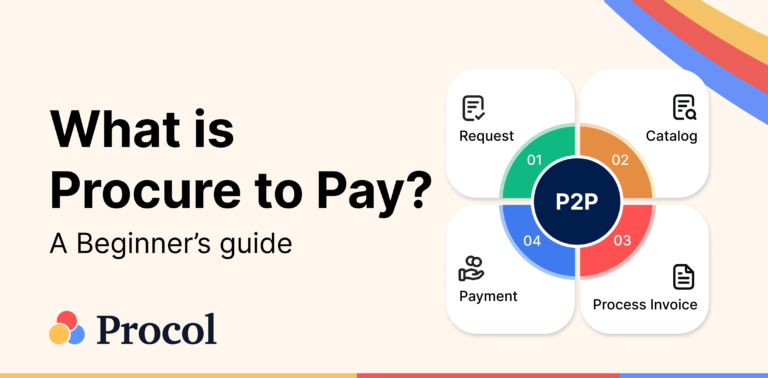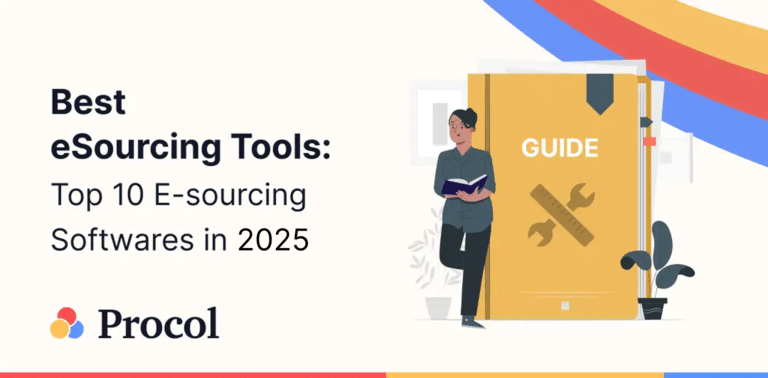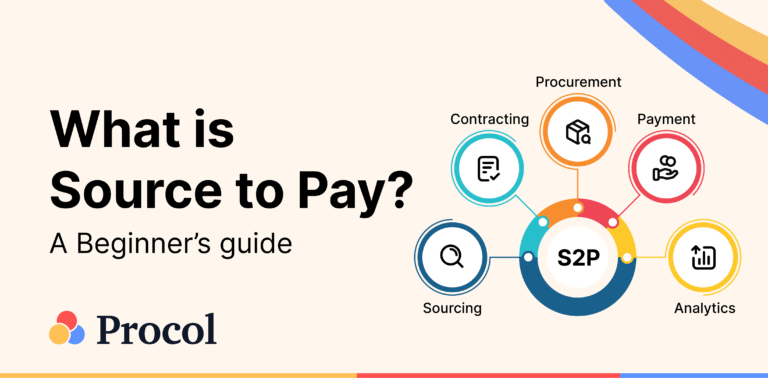Procol • April 15, 2025
11 Winning Procurement Strategies in 2024

Introduction
Procurement in terms of marketing is defined as the process of getting supplies and buying products or services, typically for business expenditures. For a business procurement strategy, solicitation and payment processing are necessary, and this typically includes multiple departments within an organization. Procurement strategy plays more than just a transactional role in companies. A company can use a procurement strategy to grow, reduce costs, improve operational effectiveness, and manage an increasingly intricate global supply chain while quickly responding to market changes.
We are aware that selecting the best procurement approach can be very challenging. This blog will assist you in selecting and better understanding the importance of getting supplies and how to choose them. It will also help you develop a firm grasp of how a procurement strategy plan can benefit your business, whether you are an aspiring startup, business owner, or entrepreneur.
What is a procurement strategy?
The procurement strategy decides how to obtain goods and services at the best possible price and quality. This helps in supporting an organization’s strategic objectives and provides it with a competitive edge. One can wonder what makes a procurement strategy necessary. A procurement strategy should introduce ideas and challenge preconceived notions to increase customer value, achieve cost savings, and promote ongoing process development.
Factors that make a procurement strategy plan necessary are:
- Increased control and visibility over spending
- Lowering costs by using strategic sourcing
- Enhanced contract fulfilment and coverage
- Enhanced connections with important suppliers
- Product development and quality control
- Enhanced value and experience for customers
- Process and policy conformance
11 types of procurement strategies
The procurement strategy differs from company to company depending on the industry and the goals. A few global procurement strategies are reducing errors, improving delivery efficiency, and adhering to relevant legislation. Another common objective is establishing strong supplier relationships to promote advantageous contracts and services. In light of these, let us look at the types of procurement strategies.
1. Risk management
Companies must be flexible to tackle risk and uncertainty in light of rising volatility. By implementing an efficient risk management plan, organizations may strengthen supplier relationships, decrease interruption, boost resilience, make better, more informed decisions, and improve compliance.
2. Cost reduction
Organizations can improve organizational functions and account for firm expenses using this strategy. Ensuring high-quality and cost-effective purchases requires putting methods into place that support vendor negotiations, find more affordable alternatives, and upgrade procurement systems.
3. Supplier optimization
Supplier optimization aims to create a more effective and efficient supply chain that can deliver higher-quality goods and services at lower prices. When optimizing suppliers, several criteria need to be taken into account, including pricing, quality, delivery, and customer service.
4. Supplier relationship management
Building strong partnerships with suppliers and giving them the tools they need to improve their capabilities are key components of supplier relationship management. To achieve this, organizations and procurement teams offer comprehensive planning and team assistance. By using vendor management software tools to improve process coordination and fortify supplier relationships, procurement managers may evaluate the effectiveness and calibre of the services they buy.
5. Global sourcing
Global sourcing is a well-defined approach to acquiring goods and services from a wide variety of foreign vendors. This strategy benefits from more competitive pricing and a wide range of suppliers that provide high-calibre, creative items.
6. Total quality management
Total quality management is a strategy that guarantees quality procurement by obtaining the appropriate items that meet the highest requirements. Companies put this method into practice by outlining their requirements for the goods they buy and by conducting extensive preliminary inspections.
7. Sustainable purchasing
Sustainable purchasing, sometimes called green purchasing, emphasizes acquiring high-quality products and services with little environmental impact. Products manufactured using reusable materials or low-energy resources are covered by this method. Businesses looking to reduce their carbon impact should consider sustainable buying.
8. Demand forecasting
The more data procurement can gather, the more precisely the function can make judgments given the increase in volatility and disruption. Through demand forecasting, organizations can plan for the retention of raw materials, manufacturing, resource allocation, pricing revisions, and expedited fulfillment.
9. Vendor development
For limited supplier selection, a vendor development strategy is used. In that scenario, obtaining strategic objectives depends on having effective vendors. It can be required to invest in cultivating such suppliers, depending on the nature of the partnership with the particular vendors and the volume and significance of the goods or services they offer. The foundation of this procurement strategy is reciprocal partnerships. A customer can assist a vendor in creating a means to deliver better or more affordable items by working closely with them, providing feedback, and making suggestions.
10. Corporate social responsibility
The procurement process must adhere to corporate social responsibility requirements according to the strategy. CSR is a firm’s strategic initiative that seeks to support societal objectives. Procurement teams inspect suppliers as part of CSR practice, looking at procedures including where to get raw materials and products, how to ship, how well workers are compensated, etc.
11. Procurement training
Given the ongoing evolution of procurement processes and techniques, this strategy might be among the most crucial. Any procurement strategy, though, must be carried out by people, and its execution may be jeopardized if the workforce lacks the necessary skills and training.
11 steps to create an ideal procurement strategy plan
Now that we know about the types of procurement strategy, the question arises about which one to choose and how to choose the one that suits your company’s requirements.
Key steps to develop an ideal procurement strategy plan include:
1. Recognizing your business’s needs
Recognizing your company’s needs to develop or enhance a plan. This includes evaluating the company’s finances, upcoming projects or undertaking requirements requiring sourcing, future corporate goals and objectives, and present and future procurement needs. This step is known as CSA, which is the current state analysis. If a procurement plan strategy is in place, evaluate its efficacy and efficiency to see if it can accommodate present and future requirements.
2. Market analysis
It is important to evaluate procurement strategies in supply chain management circumstances, new entrants, price swings, patterns, etc., recognize the state of the market, and gather the necessary information.
3. Establishing your objectives
For a procurement strategy plan, establishing your objective is one of the important steps in global procurement strategy and aims for the procurement process. Order these objectives according to their urgency. Even if it’s a minor requirement, having supplies for a project that starts next week immediately rises to the top of the list.
4. Formulate your purchasing plan
Now, consider where to find the products or services needed to achieve each of your prioritized and established goals. The sourcing strategy takes into account variables such as the calibre of the products or services, the supplier’s reputation and dependability, cost negotiations, and more. Finding the right source for the products and services to meet your procurement needs is crucial.
5. Deciding on a purchase strategy
At this stage, new operational models, protocols, and policies will be decided upon and implemented. This is a great chance to examine procedures and standards and modify them to align with the new strategy. When implementing change, convey the advantages and picture the benefits for all parties involved rather than taking on the role of process police. Recall to be adaptable. Policies that are more trouble than they are worth should be carefully examined and removed.
6. Establishing priorities for buying
The nature of procurement is dynamic, and there is an endless supply of sourcing opportunities. Opportunities will surface when armed with trustworthy spending data that has been cleaned, sorted, and classified. Implementing action plans covering the most important business-critical spending areas can find and fix underperforming subcategories. It is possible to draw attention to specific high-volume/low-value transactions.
7. Create a procurement strategy plan
At this point, you have planned the sourcing process, created a procurement strategy plan, and, if necessary, documented it. Make sure it complies with compliance and your organization’s procurement policies. While developing your approach, keep in mind to account for any potential dangers.
8. Optimizing your process
After you execute and implement your plan, keep an eye out for areas that still require improvement or to see if there are any gaps in your process. There’s always space for improvement. Keep monitoring to optimize the process.
9. Involve the parties who are involved
First, list every person to whom the proposal might affect. These consist of subject matter experts, end users, suppliers, finance, and business management teams. Managing their demands and expectations is essential. Not everyone will approve of every adjustment that has been suggested. Any strategy that doesn’t involve stakeholders is bound to fail. Some might have more information and business needs that you haven’t considered. Since stakeholders have extensive subject matter and market experience, their involvement is essential in identifying possible risks.
10. Align tactics with the objectives of the company
The plan must align with the business’s overarching strategic goal. Using fact-based spend analysis, you can prioritize and connect your strategy with business goals across all functions.
11. Take up the successful tools
Big data is slow, erroneous, and takes a lot of effort to handle manually. Leaders in decision-making with education want timely and pertinent information. With the use of the appropriate software, visibility is enabled. A focused spend analysis solution will find possibilities, boost team productivity and value addition, and cut down on errors and expensive blunders.
What is the procurement strategy framework?
Businesses can choose from a framework for procurement strategies. Suppliers, goods, or services, as well as the practices and protocols that will be applied in dealings with suppliers.
A successful procurement strategy framework must consist of the following:
- An aims and intended results statement that outlines the outputs you expect from your plan
- A tactical plan that details how your strategy will be carried out, a timeline that outlines deadlines that you must meet
A successful procurement strategy is essentially an economic plan that outlines the goals and inefficiencies of the company as well as the products and services it needs. The inputs and outputs involved in a procurement strategy framework are:
Input
- corporate & stakeholder targets, plans, & metrics
- procurement & market analytics
- procurement assessment results
- procurement strategy
Output
- gap analysis
- opportunity prioritization
- vision & targets
- resource plans
- strategic roadmap
Conclusion
Engaging in procurement is imperative, no matter what type of business you run. Your procurement strategy impacts the cost of doing business, risk factors, future objectives, financial planning, and sustainability. Thus, it becomes essential for a business’s operation and survival to carefully consider sourcing and procurement strategy plans as well as which bargaining tactics to use in the procurement process.
Purchasing tactics are essential for survival, regardless of your industry standing or level of experience in business. You require outside products and services to operate your own business, regardless of the size and scope of operations. Because of this, developing a workable sourcing or procurement strategy is just as important as setting corporate goals.
Explore more from Procol
Discover expert tips, how-to guides, industry insights, and the latest procurement trends.

What is Procure-to-pay (P2P)? An Ultimate Guide
Procure to pay is the process from procurement of materials needed...

Best eSourcing Tools: Top 10 eSourcing Software in 2025
Discover top 10 e-sourcing tools and esourcing platforms necessary for efficient...

What is Source-to-pay in 2025? An Ultimate Guide
Source to pay is the process of sourcing vendors to procure...







